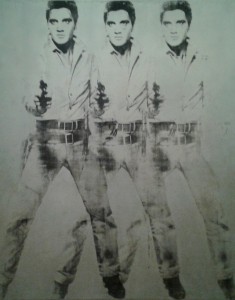
Triple Elvis, 1963, Andy Warhol (American , 1930 – 1987) Aluminum paint and printer’s ink silk-screened on canvas
Blog post courtesy of http://warholessays.tumblr.com/
Andy Warhol was born 86 years ago today. Since we have Warhol’s Triple Elvis print on display, we thought it appropriate to celebrate the King of Pop Art and his print of the King of Rock and Roll. Why is Warhol the King of Pop Art? His accessible consumer content and recognizable style made his work extremely attractive. His choice of popular celebrities as the subject matter of his pieces elevated Warhol to the social spotlight in the 1960s. As a result, royalty and other celebrities commissioned self-portraits, further compounding Warhol’s fame. In fact, two of his paintings Eight Elvises and Turquoise Marilyn are on the list of most expensive paintings ever sold! He became an icon himself as his work gained recognition. It was said that you knew you were at a good party when Warhol was there.
We are privileged to have a 1964 print of the King of Rock and Roll, Elvis Presley, by the King of Pop Art. Enjoy the blog post about Warhol and Triple Elvis below and then come see this impressive work for yourself at VMFA!
ANDY WARHOLS TRIPLE ELVIS AT THE VMFA
Our local museum, the Virginia Museum of Fine Arts has a wonderful example of Andy Warhol’s work with the Triple Elvis. This is a triptych of Elvis Presley pointing a gun at the viewer, done with aluminum paint and printer’s ink silk-screened on canvas.
This is part of numerous similar paintings of Elvis that Andy Warhol created in 1963-64. The original Elvis image is taken from a publicity still for a Western starring Elvis Presley, Flaming Star. Another version of this painting, Double Elvis, was auctioned by Sotheby’s for $37 million. Another version, 8 Elvises, sold to a private collector for $100 million,
These paintings were part of the famous solo art show that Andy Warhol presented at the Ferus Gallery in Los Angeles in 1963. This exhibition focused on celebrity as a theme, and Andy chose the two reigning stars of the time – Elizabeth Taylor and Elvis Presley for his subjects, rendered in silver, in acknowledgement of their larger-than-life status on the silver screen. Leslie Prouty of Sotheby’s termed this “… the perfect alignment of artist and subject,” These were also the only full-figure Elvis paintings that Andy did. He went on to leverage the representational style of these paintings in many subsequent works, such as the Marilyn Monroe, Black in 1967.
Andy Warhol also conveyed the commercial nature of these paintings by his choice of how they were to be displayed. He shipped the entire set as a long roll of canvas and stretchers to Irving Blum, a director at the Ferus Gallery, and asked him to “cut them any way you think…they should be cut,” The repetitive nature of the layout provoked one critic to say, “Toe to toe, repeated atop one another, poor Elvis becomes as thin and hazy as the idyllic illusion he publicly symbolizes; the assembly line produces the emptiness and sterility of soulless, over-managed puppetry.” The 22 different Elvis paintings we know today emerged when the installation was cut up after the exhibition ended, 9 of which are present in museums around the world.
Critic David McCarthy studied the process and the works in his essay Andy Warhol’s Silver Elvises: Meaning Through Context At the Ferus Gallery in 1963 in the Art Bulletin in 2005. He said that ‘Warhol knowingly drew attention to cinematic convention, while also continuing to position his work in relation to contemporary vanguard art.” He also noted that Warhol may have been inspired by Duchamp’s The Bride Stripped Bare by her Bachelors. The essay is a delight to read in its entirety.
The process that Andy Warhol used here, and would go on to leverage was in line with his vision of the machine as the archetype of the modern age. He told Art News interviewer Gene Swenson, “The reason I’m painting this way is that I want to be a machine, and I feel that whatever I do and do machine-like is what I want to do.” The process brought back the 1950s style of creating prints using silkscreening. As Sotheby’s put it, “Warhol investigated through multiplicity the commodification of fame.” Modern giclee printing has made the process even more mechanized, and enabled homes across the world to display these images.
Warhol recalled that his attempts at making these paintings was challenging. He did them in a studio he set up in an abandoned fire station in New York with poet Gerard Malanga. He said that the experience “was pretty scary You literally had to hopscotch over holes in the floor And the roof leaked. But we didn’t really notice all that much, we were busy getting the Elvises and the Liz Taylor silkscreens ready to ship out to California [for the exhibition at Ferus Gallery Los Angeles]. One night that summer there was a terrible thunderstorm and when I came in the next mowing, the Elvises were sopping wet — I had to do them all over again.
More recently, Adam Lambert from American Idol recreated the Elvis pose for OUT magazine in 2011 when they named him to their annual 100 List. This also connected with Andy Warhol in other ways, as it was a rapprochement between OUT and Adam Lambert, after the singer posed in Details magazine earlier with a nude model, almost covering up his homosexuality, much as Andy Warhol did in his life. The British Pop Art artist Simon Dixon was inspired by Andy Warhol, creating similar, more colorful works like those on Buddy Holly and also Elvis himself.